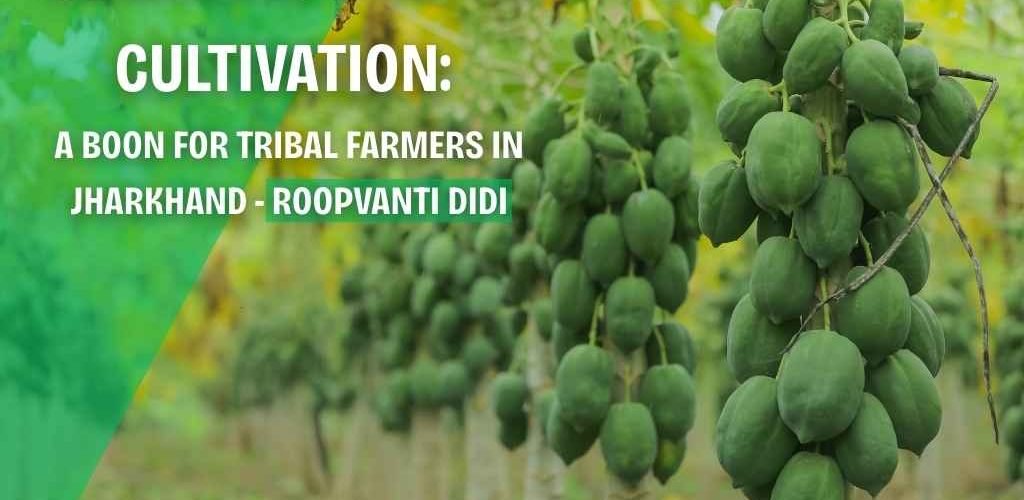Scientific Papaya Cultivation: A Boon for Tribal Farmers in Jharkhand
Scientific Papaya Cultivation: A Boon for Tribal Farmers in Jharkhand

Papaya, an important fruit crop in Jharkhand, has traditionally been grown in backyard gardens for household consumption. However, scientific methods of papaya cultivation have remained largely unexplored by the state’s tribal farmers. Recognizing the need to bridge this gap, the Farming System Research Centre for Hill and Plateau Region, Ranchi, under ICAR-RCER, initiated a technology demonstration on scientific papaya cultivation in Gumla, Ranchi, and Lohardaga districts during 2018-19. This initiative was carried out under the Tribal Sub Plan of the ICAR-All India Coordinated Research Project on Fruits.
To mobilize tribal farmers, PRADAN (Professional Assistance for Development Action), an NGO dedicated to farm livelihood development, extended its support. Extensive training sessions and exposure visits were conducted, benefiting approximately 1,300 tribal farmers before the planting process began.
The demonstration involved the cultivation of improved papaya varieties such as Red Lady, NSC 902, and Ranchi Local in over 600 farmers’ fields, totaling 30,000 plants. While Ranchi Local was a preferred variety due to its resilience and pest resistance, its dioecious nature limited fruit production to only 50%-60% of the plants. To overcome this challenge, the innovative practice of planting three seedlings per pit and removing male plants after flowering was introduced. This technique increased the fruit-bearing plants to 80%-90%, boosting production by 30%-40% over traditional methods.
A Success Story: Roopvanti Didi’s Journey
Smt. Roopvanti Didi from Dubang village in Lohardaga district adopted this scientific approach, planting 45 Ranchi Local papaya plants in a 200 m² area. With 38 of her plants bearing fruit, she started selling unripe papayas for vegetable use after just 5-7 months, earning Rs. 8,550/-. Later, she sold ripe fruits between 10-13 months, making an additional Rs. 7,400/-. In total, she earned Rs. 15,950/- from her small-scale papaya cultivation.
Advancements in Disease and Nutrient Management
To further enhance productivity, farmers were introduced to micro-nutrient applications, particularly boron (0.3%). Regular boron sprays (four applications) significantly reduced flower and fruit drop by 22%-35% and increased yield by 15%-20%. Additionally, an integrated approach was adopted to combat Papaya Ring Spot Virus (PRSV), a major threat in the region. Measures such as using disease-free seedlings, avoiding virus host plants (e.g., cucurbits and solanaceous vegetables), timely weeding, and spraying neem oil at monthly intervals, along with systemic insecticides, helped reduce PRSV incidence by 50%-60%.
Impact and Expansion
This initiative proved to be a game-changer for tribal farmers, increasing their income from Rs. 1,200/- to Rs. 1,75,000/- depending on their cultivated area and management practices. Inspired by the success, more farmers in nearby villages have shown keen interest in papaya cultivation.
Recognizing the growing demand for quality planting material and entrepreneurship opportunities, the project promoted papaya nursery raising in a participatory mode. Sixteen progressive farmers from Gumla and Lohardaga districts received training on improved nursery techniques and were supplied with essential inputs like polybags and seeds under the Tribal Sub Plan. As a result, over 28,000 seedlings were produced and sold to nearly 1,000 farmers in April-May 2020. Selling at an average price of Rs. 10 per plant, nursery growers earned an average profit of Rs. 12,000/- within three months.
A Sustainable Livelihood Opportunity
The additional income from nursery activities, particularly during the COVID-19 lockdown, was a financial lifeline for farmers. The success of this initiative has inspired more tribal farmers, prompting the Jharkhand government to promote papaya cultivation through various state and centrally sponsored schemes. With continued support from scientific institutions, scientific papaya farming has the potential to become a reliable income source for migrant laborers and tribal communities in Jharkhand in the years to come.
(Source: ICAR-Research Complex for Eastern Region, Patna & ICAR-All India Coordinated Research Project on Fruits)